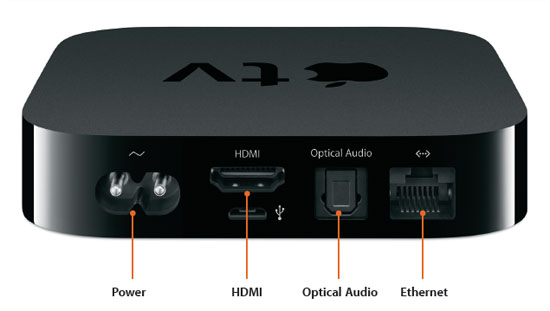Apple TV Wireless HD Media Streamer Review
Design

Unlike the WD and Seagate media players, which both feature hard drives for local storage of media files, the Apple TV is a streaming-only device. Like Roku, the Apple TV gets all of its content via a network connection (the WD and Seagate media player devices also have network connection capabilities for streaming media). This is a marked difference from the previous iteration of the Apple TV, which came with an integrated hard drive for local media storage, in addition to its streaming capabilities. By eschewing the hard drive, the new Apple TV’s form factor is 80-percent smaller and consumes 90-percent less power than the previous generation Apple TV. It also runs very cool, no matter what task it’s performing.
One area where the WD and Seagate media players have an advantage over the Apple TV is in supported video resolution. The Apple TV tops out at 720p, while both the WD and Seagate media players (as well as many other media players, for that matter) support up to 1080p. For online-based streaming media, this is actually not as big of a deal as your might think. Streaming media from Internet sources (such as from an iTunes Store rental, Netflix movie, or YouTube video) tends to be highly compressed, so the difference in image quality between 720p and 1080p isn’t likely to be all that great. Where this difference comes into play, however, is when you’re playing video you’ve encoded. If you have a high-bit-rate (low-compression), 1080p video, you would probably notice the difference.
The new Apple TV is a small black box that measures a mere 0.9x3.9x3.9-inches and weighs only 0.6-pounds. All of its connections are located on its backside and include power, HDMI, a Micro USB port (which is “for service and support” only), optical audio-out, and 100Mbps Ethernet. Inside the box is an Apple A4 processor, 802.11a/b/g/n radio, and a 6-Watt power supply (there is no external power supply brick, just a simple power plug). According to market-research company, iSuppli, there’s also 8GB of NAND flash storage and 256MB of memory.
8GB of storage is an awful lot—even for caching several full-length movie rentals. This coupled with the discovery that the Apple TV runs a version of iOS (the same operating system that powers the iPhone, iPad, and iPod touch), has sparked speculation that it won’t be long before Apple opens the app door for the Apple TV as well—letting users install apps onto their Apple TVs. Some pundits have even gone so far as to suggest that with an Apple A4 processor humming along inside the Apple TV, it has the potential to even be a viable gaming platform. Time will tell.
The Apple TV comes with latest version of the Apple Remote; this is the same remote control that's a $19 option for iMacs and MacBooks. The remote features just a few simple controls: a four-way directional control for navigating through onscreen menus, a select button, a menu button, and a play/pause button. The remote works well with the Apple TV, but keep in mind that since it is an IR remote it must be within the line of site of the Apple TV in order to work.
The Apple Remote isn’t your only option for operating the Apple TV. You can easily program a universal remote to control all of the Apple TV’s features—we did so successfully with a Logitech Harmony remote. If you own an iPhone or iPod touch, you can also control the Apple TV using the free Remote app. One distinct advantage the Remote app has over the physical Apple Remote is that whenever you have to input information (such as your iTunes username or password), the Remote app gives you access to a full QWERTY keyboard. Otherwise, with the Apple Remote, you have to use the four-way directional controls to pick one character at a time. Another advantage to using the Remote app is that it communicates with the Apple TV over a network connection, so your iPhone/iPad/iPod touch doesn’t need to be in line of site with the Apple TV.










